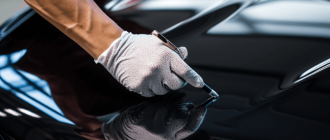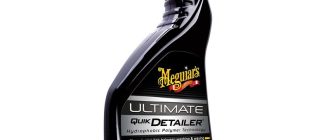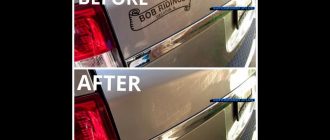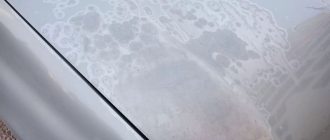How to Fix Small Scratches on Your Car
If you own a car, you know how frustrating it can be to discover small scratches on the surface. No matter how careful you are, these imperfections can appear out of nowhere and ruin the overall appeal of your vehicle. However, there’s no need to panic! In this step-by-step guide, we will show you how to fix those annoying scratches on your car.
Firstly, it’s essential to understand that not all scratches require a trip to the auto body shop. In fact, many small scratches can be easily repaired at home with a few simple tools and a little bit of patience. With this guide, you’ll be able to save time and money by fixing the scratches yourself.
So, how do you go about repairing these small scratches on your car? The first step is to assess the damage. Determine the depth of the scratch by running your fingernail over it. If your nail doesn’t catch, the scratch is likely on the clear coat, which means it can be fixed easily. However, if your nail does catch, the scratch may be deeper and require additional steps to repair.
Now that you know the depth of the scratch, it’s time to gather the necessary supplies. You’ll need a microfiber cloth, a scratch repair kit, and some wax or polish. These items are readily available at most automotive supply stores. Once you have all the necessary tools, you can proceed with the repair process.
Remember, patience is key when repairing scratches on your car. Take your time and follow the instructions provided in the scratch repair kit. By carefully applying the products and using the right techniques, you’ll be able to restore your car’s surface to its former glory.
How to Repair Small Scratches on Your Car
Sometimes small scratches can appear on your car, whether from a stray shopping cart, a key, or other objects. These scratches can be unsightly and can even lead to rust if left untreated. Fortunately, there are steps you can take to easily fix small scratches on your car.
First, gather your materials. You will need a microfiber cloth, some rubbing compound, and a car polish or wax. Make sure to choose a rubbing compound and polish that matches the color of your car.
Start by cleaning the scratched area with soap and water. This will remove any dirt or debris from the scratch, allowing for a smoother repair. Dry the area thoroughly with a clean cloth.
Next, apply a small amount of rubbing compound to the scratched area. Use the microfiber cloth to gently rub the compound into the scratch, using circular motions. Be sure to follow the instructions on the rubbing compound packaging for best results.
After rubbing the compound in, inspect the area to see if the scratch has been reduced. If the scratch is still visible, repeat the process until the scratch is less noticeable. Remember to be patient, as it may take several applications to fully repair the scratch.
Once the scratch has been minimized, apply a small amount of car polish or wax to the area. Use the microfiber cloth to gently buff the polish or wax into the scratched area, again using circular motions. This will help to blend the repaired area with the surrounding paint.
Finally, stand back and admire your work. The small scratch should now be much less noticeable, if not completely gone. You can repeat this process for any other small scratches on your car to keep it looking its best.
Remember, this method is best for small scratches. If you have deep or extensive damage, it’s best to consult a professional for repair. By following these steps, you can easily fix small scratches on your car and keep it looking like new for years to come.
Gather the necessary materials
If you want to fix small scratches on your car, you will need a few essential materials:
- Microfiber cloth
- Car wash soap
- Water
- Automotive touch-up paint that matches your car’s color
- Clear coat
- Sanding block
- Sandpaper with various grits (1500 to 3000)
- Polishing compound
- Wax
- Applicator pads
Make sure you have all of these materials before you start the process of repairing the scratches on your car.
Clean the scratched area
To fix small scratches on your car, the first step is to clean the scratched area. This will help remove any dirt or debris that may be stuck in the scratch, allowing for a smoother repair process.
Start by washing the area around the scratch with a mild detergent and water. Use a soft sponge or cloth to gently scrub the area, being careful not to apply too much pressure as this could further damage the paintwork.
After rinsing off the detergent, dry the area thoroughly with a clean towel or microfiber cloth. This will ensure that there is no residual moisture left behind, which could affect the adhesion of the repair materials.
Next, use a primer or a specialized cleaner specifically designed for scratch repair. Apply a small amount of the product onto a clean cloth and gently rub it into the scratched area. This will help remove any wax or grease that may still be present on the surface, allowing for better adhesion of the touch-up paint.
Once the scratched area is clean and dry, you are now ready to proceed with the next steps of repairing the small scratches on your car.
Assess the depth of the scratch
Before you can fix the small scratches on your car, it’s important to assess the depth of the scratch. This will help you determine the best course of action to take in order to repair it effectively.
To assess the depth of the scratch, you can run your finger over it gently. If you can feel the scratch with your finger, it means it has gone through the clear coat and into the paint layer. In this case, the scratch may require a touch-up paint job to fix it completely.
If the scratch is only on the clear coat and can’t be felt with your finger, it is considered a surface-level scratch. These types of scratches can often be buffed out using a polishing compound and a microfiber cloth. However, if the scratch is deep and extends beyond the clear coat, it may require more extensive repair, such as sanding and repainting the affected area.
By assessing the depth of the scratch, you’ll be able to determine the best approach to fix it and restore the appearance of your car.
Choose the appropriate repair method
When it comes to fixing small scratches on your car, it’s important to choose the appropriate repair method. The method you choose will depend on the severity of the scratches and the type of finish on your car.
If you have minor surface scratches, you may be able to fix them with a simple polishing compound. This method involves applying the compound to the scratches and gently rubbing it in with a soft cloth. The polishing compound will help to smooth out the scratches and restore the shine to your car’s finish.
For deeper scratches that have gone through the clear coat and paint, you may need to use a touch-up pen or paint repair kit. These products are designed to match your car’s paint color and allow you to fill in the scratches. After applying the paint, you can use a fine-grit sandpaper to smooth out the area and blend it with the surrounding paint.
In some cases, you may need to use a more advanced repair method such as wet sanding or using a rubbing compound. Wet sanding involves using a sanding block and water to gently sand down the scratches and remove any imperfections. Rubbing compound is a more aggressive method that involves using a compound specifically designed to remove scratches and restore the shine to your car’s finish.
| Polishing Compound | Minor surface scratches | Light scratches and scuffs |
| Touch-up Pen or Paint Repair Kit | Deeper scratches | Scratches that have gone through the clear coat and paint |
| Wet Sanding | Deep scratches | Scratches that require more extensive repair |
| Rubbing Compound | Deep scratches | Scratches that require more aggressive repair |
Before choosing a repair method, it’s important to carefully assess the scratches on your car. Consider the severity of the scratches and the time and effort you are willing to put into the repair process. With the right repair method, you can easily fix small scratches on your car and restore its appearance.
Sand the scratch
After identifying the small scratch on your car, the next step is to sand it. Sanding the scratch helps to smooth out the surface and prepare it for the next steps in the repair process.
To sand the scratch, you will need fine-grit sandpaper. Start by wetting the sandpaper with water to minimize dust and friction. Gently sand the scratch in a back-and-forth motion, being careful not to apply too much pressure. The goal is to remove any rough edges and create a smooth surface.
It is important to be patient and take your time when sanding the scratch. Rushing through this step can result in further damage to your car’s paint job. If you are uncertain about the process, it is always best to seek professional help.
Once you have finished sanding the scratch, wipe away any residue and inspect the area. If the scratch is still visible, you may need to repeat the sanding process or move on to the next step in the repair process. Remember, fixing small scratches on your car requires attention to detail and a methodical approach.
Apply primer to the scratch
After preparing the surface of your car and removing any dirt or debris, it’s time to apply primer to the small scratch. The primer will help the paint adhere better to the surface and improve the overall finish of the repair.
To apply the primer, follow these steps:
- Clean the scratch area with a mild detergent and water, then rinse and let it dry completely.
- Use a small brush or applicator to apply a thin coat of primer to the scratch. Make sure to cover the entire area and feather the edges of the primer into the surrounding paint.
- Allow the primer to dry according to the manufacturer’s instructions. This usually takes around 15-30 minutes.
- If necessary, apply a second coat of primer for better coverage and adhesion. Follow the drying time instructions again.
Once the primer is dry, you can proceed to the next step of the repair process, which is applying touch-up paint to the scratch.
Apply touch-up paint
Once you have prepared your car and filled in the small scratches, it’s time to apply touch-up paint to complete the repair process. Touch-up paint is specifically designed to match your car’s color and provide a seamless finish.
Here’s how to apply touch-up paint:
- Shake the touch-up paint bottle well to ensure that the color is properly mixed.
- Clean the area around the scratch using a soft cloth and mild soap to remove any dirt or wax. Make sure the area is completely dry before proceeding.
- Using a fine-tip brush or an applicator provided with the touch-up paint, carefully apply a thin layer of paint to the scratch. Avoid applying too much paint, as it can create an uneven surface.
- Allow the paint to dry completely. This typically takes around 15-30 minutes, but follow the instructions on the touch-up paint bottle for specific drying times.
- If necessary, repeat the process by applying additional thin layers of paint until the scratch is completely covered. Allow each layer to dry before applying the next one.
- Once the paint is dry, use a fine-grit sandpaper or a polishing compound to gently buff the painted area, blending it with the surrounding paint. This will help achieve a smooth and seamless finish.
Remember to follow the instructions provided with your touch-up paint for the best results. Also, be patient and take your time to ensure a professional-looking repair. With these steps, you can fix small scratches on your car and restore its appearance.
Blend the paint
Once you have applied the touch-up paint to the scratched area of your car, it’s important to blend the paint properly to achieve a seamless repair. Blending the paint helps to ensure that the color and texture of the touch-up paint match the surrounding paint, making the repair less noticeable.
To blend the paint, you can use a microfiber cloth or a sponge applicator. Gently dab the cloth or sponge on the painted area, spreading the touch-up paint and feathering the edges. This technique helps to blend the new paint with the old paint, creating a smooth transition.
Be careful not to apply too much pressure or rub too vigorously, as this can cause the paint to smear or create an uneven finish. Instead, use light, circular motions to blend the paint and achieve a seamless repair.
After blending the paint, allow it to dry completely according to the instructions on the touch-up paint product. This may take a few hours or longer, depending on the paint and weather conditions. Once the paint is dry, you can assess the result and make any necessary touch-ups or adjustments.
Remember, blending the paint is an important step in the repair process to ensure a professional-looking finish. With a little patience and attention to detail, you can fix small scratches on your car and restore its appearance.
Let the paint dry
Once you have applied the touch-up paint to the small scratches on your car, it is important to let the paint dry completely before handling or touching the area. This will help to ensure that the paint adheres properly and does not smudge or smear.
To allow the paint to dry effectively, it is best to leave your car parked in a well-ventilated area for at least 24 hours. Avoid driving or exposing the freshly painted area to rain or moisture during this time. Keep in mind that the drying time may vary depending on the type of paint and the weather conditions.
If you are in a hurry and need to expedite the drying process, you can use a hairdryer at a low setting to gently heat the painted area. However, be cautious not to overheat the paint or hold the hairdryer too close to the surface, as this can cause damage.
Once the paint has dried completely, you can inspect the repaired area to ensure that the small scratches have been effectively fixed. If there are any imperfections or areas that still require touch-up, you can repeat the process as necessary.
Remember, proper drying is crucial to achieving a seamless and long-lasting repair for small scratches on your car. Be patient and allow the paint to dry thoroughly before moving on to the next step.
Polish the repaired area
Once you have finished applying the touch-up paint and it has dried completely, the next step is to polish the repaired area. This will help to blend the paint with the surrounding car surface and make the scratch less noticeable.
To polish the repaired area, you will need a clean microfiber cloth and a high-quality car polish. Apply a small amount of the polish to the cloth and then gently buff the area in a circular motion. Make sure to focus on the edges of the scratch to ensure a seamless blend.
Continue buffing the area until the paint is smooth and shiny. You may need to apply more polish as you go, depending on the severity of the scratch. Take your time and be patient, as this step is crucial for achieving a professional-looking result.
Once you are satisfied with the polished look of the repaired area, step back and admire your handy work. The scratch should now be significantly less visible, and your car will look much better.
Remember, it’s important to fix small scratches on your car as soon as possible. By following these steps, you can easily repair minor scratches and restore the appearance of your vehicle.
Protect the repaired area
After you have successfully fixed the small scratches on your car, it is essential to take steps to protect the repaired area. This will ensure that the scratches do not reappear and that your car maintains a smooth and flawless finish.
Here are a few steps on how to protect the repaired area:
| Step 1: | Apply a layer of clear coat on the repaired area. This will provide an additional protective barrier and help seal the repaired scratches. |
| Step 2: | Use a high-quality wax or sealant to further protect the repaired area. Apply the wax or sealant according to the instructions provided. |
| Step 3: | Consider using a paint protection film or a clear bra on the repaired area. This will provide long-term protection against scratches and other damages. |
| Step 4: | Maintain regular cleaning and maintenance of your car. This includes washing, waxing, and using a microfiber cloth to gently clean the repaired area. |
| Step 5: | Avoid parking your car in areas where it is likely to get scratched, such as crowded parking lots or close to trees with low branches. |
By following these steps, you can protect the repaired area and ensure that your car stays scratch-free for as long as possible. Remember, prevention is always better than cure!
Inspect the repair
Once you have followed the steps on how to fix small scratches on your car, it is important to inspect the repair.
Take a moment to carefully examine the area where the scratches were located. Use adequate lighting and get down to eye level with the paint surface, if possible.
Look for any remaining scratches or imperfections. Sometimes, small scratches may still be visible or you may notice other imperfections, such as uneven paint or noticeable touch-up marks.
If you spot any issues, you may need to repeat the repair process or consider seeking professional assistance.
Additionally, check for any signs of paint discoloration or blending issues. The newly repaired area should blend in seamlessly with the surrounding paint. If there are noticeable differences in color or texture, it may indicate an improper repair.
Make sure to run your fingers lightly over the repaired area to see if you can feel any unevenness or roughness. A properly repaired surface should feel smooth to the touch.
By thoroughly inspecting the repair, you can ensure that the small scratches on your car have been effectively fixed and that the overall appearance of your vehicle is restored.
Prevent future scratches
In addition to knowing how to fix small scratches on your car, it’s also important to take steps to prevent future scratches. Here are some tips to help you keep your car scratch-free:
| 1. Be mindful of where you park: | Choose parking spots away from busy areas, shopping carts, and other potential hazards that could cause scratches. |
| 2. Use a car cover: | Invest in a car cover to protect your vehicle from outdoor elements that can lead to scratches, such as tree branches, bird droppings, and dust. |
| 3. Wash your car regularly: | Regularly washing your car will help remove debris and dirt that can cause scratches. Use a microfiber cloth or a sponge designed for car washing to avoid scratching the paint. |
| 4. Avoid automatic car washes: | While convenient, automatic car washes can sometimes cause more harm than good. Opt for hand washing or touchless car washes to minimize the risk of scratches. |
| 5. Use touch-up paint: | If you notice any small chips or scratches, use touch-up paint to address them promptly. This will prevent them from worsening and becoming more noticeable. |
| 6. Install paint protection film: | Consider adding a clear paint protection film to vulnerable areas of your car, such as the front bumper and hood. This protective film can help shield your car from scratches and chips. |
By following these tips and taking proper care of your car, you can minimize the risk of small scratches and keep your vehicle looking great for years to come.
Question-answer:
Is it possible to repair small scratches on a car by myself?
Yes, it is possible to repair small scratches on a car by yourself. With the right tools and techniques, you can easily fix minor scratches and make your car look like new again.
What tools do I need to repair small scratches on my car?
To repair small scratches on your car, you will need a microfiber cloth, a scratch repair pen or touch-up paint, rubbing compound, and a clear coat. These tools will help you effectively remove and repair the scratches.
Can I use toothpaste to fix small scratches on my car?
While some people claim that toothpaste can help remove small scratches on cars, it is not recommended. Toothpaste is abrasive and can potentially damage the car’s paint. It’s best to use products specifically designed for car scratch repair.
What is the process of repairing small scratches on a car?
The process of repairing small scratches on a car involves cleaning the scratched area, applying touch-up paint or scratch repair pen, blending in the paint, using rubbing compound to smooth out the surface, and applying a clear coat for protection. The entire process may take a few hours to complete.
Can I repair deep scratches on my car using the same method?
No, the method mentioned in the article is suitable for repairing small scratches only. If you have deep scratches on your car, it is recommended to take it to a professional auto body shop for repairs. Deep scratches require more extensive work and specialized tools.
What are some common causes of small scratches on cars?
Common causes of small scratches on cars include brushing against bushes or tree branches, accidental contact with other vehicles or objects, and parking lot mishaps.





